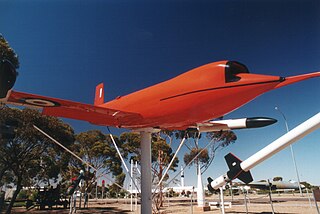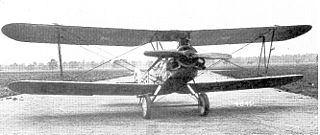
The Royal Aircraft Factory B.E.2 is a British single-engine tractor two-seat biplane, designed and developed at the Royal Aircraft Factory. Most of the roughly 3,500 built were constructed under contract by private companies, including established aircraft manufacturers and firms new to aircraft construction.

The Avro 504 is a single-engine biplane bomber made by the Avro aircraft company and under licence by others. Production during World War I totalled 8,970 and continued for almost 20 years, making it the most-produced aircraft of any kind that served in any military capacity during the First World War. More than 10,000 were built from 1913 until production ended in 1932.

The Hawker Hart is a British two-seater biplane light bomber aircraft that saw service with the Royal Air Force (RAF). It was designed during the 1920s by Sydney Camm and manufactured by Hawker Aircraft. The Hart was a prominent British aircraft in the inter-war period, but was obsolete and already side-lined for newer monoplane aircraft designs by the start of the Second World War, playing only minor roles in the conflict before being retired.

The Bristol F.2 Fighter is a British First World War two-seat biplane fighter and reconnaissance aircraft developed by Frank Barnwell at the British and Colonial Aeroplane Company later known as the Bristol Aeroplane Company. It is often simply called the Bristol Fighter, "Brisfit" or "Biff".

The Fairey Aviation Company Fairey III was a family of British reconnaissance biplanes that enjoyed a very long production and service history in both landplane and seaplane variants. First flying on 14 September 1917, examples were still in use during the Second World War.

The Royal Aircraft Factory R.E.8 is a British two-seat biplane reconnaissance and bomber aircraft of the First World War that was designed and produced at the Royal Aircraft Factory. It was also built under contract by Austin Motors, Daimler, Standard Motors, Siddeley-Deasy and the Coventry Ordnance Works.

The Avro 626 is a single-engined British biplane trainer aircraft produced by Avro during the (1918-1939) inter-war period.

The Junkers W 34 was a German-built, single-engine, passenger and transport aircraft. Developed in the 1920s, it was taken into service in 1926. The passenger version could take a pilot and five passengers.

The Canadian Vickers Vedette was the first aircraft designed and built in Canada to meet a specification for Canadian conditions. It was a single-engine biplane flying boat purchased to meet a Royal Canadian Air Force (RCAF) demand for a smaller aircraft than the Vickers Viking with a much greater rate of climb, to be suitable for forestry survey and fire protection work. The type went on to have a long and distinguished career in civil operations in Canada. Most of the topographical maps in use in Canada today are based on photos taken from these aircraft.

The Airco DH.9 – also known after 1920 as the de Havilland DH.9 – is a British single-engined biplane bomber that was developed and deployed during the First World War.

The de Havilland DH.50 was a 1920s British large single-engined biplane transport built by de Havilland at Stag Lane Aerodrome, Edgware, and licence-built in Australia, Belgium, and Czechoslovakia.

The Blackburn T.3 Velos was a 1920s British two-seat coastal defence seaplane built by Blackburn Aeroplane & Motor Company Limited, Brough Aerodrome and the Greek National Aircraft Factory.

The GAF Jindivik is a radio-controlled target drone produced by the Australian Government Aircraft Factories (GAF). The name is from an Aboriginal Australian word meaning "the hunted one". Two manually-controlled prototypes, were built as the GAF Pika as a proof of concept to test the aerodynamics, engine and radio control systems, serialled A92-1/2, 'B-1/2'. The radio-controlled Jindivik was initially designated the Project B and received serials in the A93 series. Pika is an Aboriginal Australian word meaning flier.

The Avro 547 was a prototype triplane airliner developed in Britain after the First World War. It utilised components from the highly successful 504 but added an extra set of wings and a new deep fuselage housing a fully enclosed cabin to seat four passengers. The aircraft was powered by a 160 hp (120 kW) Beardmore engine. The pilot sat in an open cockpit offset to port. The prototype flew well, having similar characteristics to a 504, the second example built was substantially modified, in order to compete in a British Air Ministry competition for a commercial aircraft, being fitted with a 240 hp (180 kW) Siddeley Puma engine. Designated 547A, this version turned out to be slow and unstable in the air and failed to win an award in the competition in August 1920. Damaged in a forced landing at the competition, the second prototype was scrapped in 1922.

The Bristol Taxiplane and Bristol Primary Trainer were British single-engine biplane light aircraft built by the Bristol Aeroplane Company in the early 1920s. A total of 28 were built, being mainly used as trainers.

The Airco DH.9C was a British passenger aircraft.

The Bristol Type 118 was a general-purpose military aircraft, a two-seat biplane built by the Bristol Aeroplane Company in the early 1930s, powered by a Bristol Mercury radial engine and aimed at overseas markets. The Type 120 was a Bristol Pegasus-engined variant entered into an Air Ministry competition and later used for armament tests. Two aircraft were built.
The Sopwith Antelope was a British three-seat transport aircraft built after the end of the First World War. A single-engined biplane based on the Sopwith Wallaby long-range aircraft, only a single Antelope was built.

The Stampe et Vertongen SV.5 Tornado was a military trainer aircraft designed and built in Belgium in the 1930s. It saw service with the Belgian Air Force and Latvian Air Force, and Latvian firm VEF purchased a production license, although it is uncertain whether it built any examples.

The Kaproni Bulgarski KB-11 Fazan was a 1940s Bulgarian army liaison and utility monoplane built by Kaproni Bulgarski, a subsidiary of the Italian aviation conglomerate Società Italiana Caproni.



















